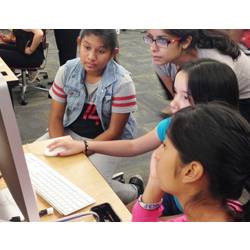
Science, technology, engineering and mathematics (STEM) fields might be getting more inclusive, thanks to a recent wave of U.S. federal funding for initiatives that seek to boost the number of women and minorities in these fields.
According to data from the U.S. National Science Foundation (NSF), this could not come at a better time. Since 2000, the number of underrepresented minorities who earned degrees in engineering and the physical sciences has not risen; in math and statistics, the number dropped. While the number of degrees earned by women across fields has generally risen, the proportion of women is “lowest in engineering, computer science, and physics,” says the NSF.
Funding from organizations like the NSF aims to change that. In 2014, the organization awarded $500,000 to an initiative called Co-Robots for COMPUGIRLS (Culturally Responsive Robotics Education for Underrepresented Girls), a program to create more inclusion in robotics.
Says principal investigator Andrew Williams, “Our Co-Robots for COMPUGIRLS grant allows us to develop culturally responsive humanoid robotics curriculum and evaluate whether our approach of combining social justice interests with technology is effective or not.”
A former Senior Engineering Diversity Manager at Apple, Williams and his collaborators are using research to determine the most effective ways to include girls in robotics through inclusive curriculums at schools. Currently, the program is preparing articles to disseminate its research results and see if it can scale what works to other institutions besides schools it has worked with in Milwaukee and Phoenix. The funding is also used to test what works and what does not, a practice sometimes lacking from well-meaning initiatives.
“Many times our new computer science or robotics programs lack scientific evaluation to validate what works,” says Williams.
Another Silicon Beach
Florida is a hotspot for computer science jobs, according to Florida Atlantic University (FAU). Yet Hispanics, who make up 23% of the state’s population, and 22% of the workforce in places like Palm Beach, FL, are underrepresented in the field.
A $4.4-million U.S Department of Education grant awarded to FAU will work to change that by providing funding for a project called the Hispanic Serving Institutions project (Title III). The project, says project director and principal investigator Ali Zilouchian, is to diversify the STEM workforce in computer science.
“It’ll do that through a combination of gateway course improvements, and student academic and motivational support,” he says. “In the short term, we will increase our students’ success in passing gateway courses, which are requirements for a bachelor’s degree in computer science, computer engineering and electrical engineering programs, and provide them with a path for their future careers in IT related sectors.”
The program involves collaboration between Broward College and Palm Beach State College, two of the largest state colleges in South Florida, with FAU to improve diversity in these fields.
“In the long term, we believe this diversity gives our project an edge in addressing the needs of Florida’s workforce through culturally competent pedagogy and career development,” says Zilouchian.
This is not just an East Coast thing; another program on the other side of the country is also fostering inclusion in tech.
Opportunity for All
San Francisco State University is at ground zero of tech innovation in the U.S., but the school sees much more to the future than the latest app or venture-funded unicorn.
The school has received nearly $15 million from the NSF and the National Institutes of Health for, among other initiatives, diversifying computing. A project called “San Francisco: Computing for All Levels and Learners” (SF CALL), has been allocated $300,000 “to promote a robust context for computing that, as noted by President Obama, recognizes computing as a basic and core component of education,” says Keith Bowman, dean of the school’s College of Science and Engineering.
As part of that mission, the program has created teams of teachers to make computing more accessible at the grade school, high school, and college levels. Those efforts hinge on reducing achievement gaps between minority students and others who enter STEM fields.
The result of the San Francisco State program, and similar efforts from COMPUGIRLS and FAU, could change the face of tech for the better, creating an industry of the future that looks like all of the U.S., not just a fraction of it. In that scenario, everyone benefits.
“Inclusion and advancing opportunities for all is essential to ensuring a strong future workforce,” says San Francisco State’s Bowman. “But inclusive teams are also more likely to produce better products and solutions that involve and serve everyone.”
Logan Kugler is a freelance technology writer based in Tampa, FL. He has written for over 60 major publications.



Join the Discussion (0)
Become a Member or Sign In to Post a Comment